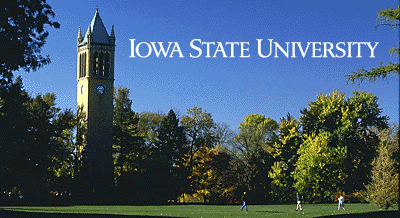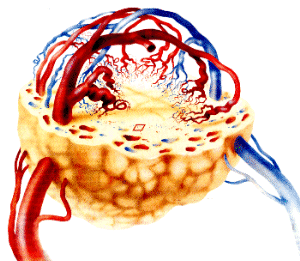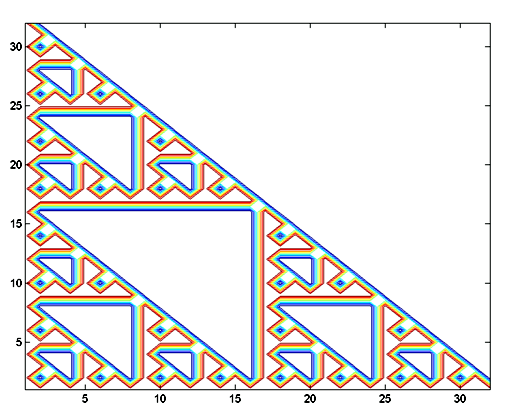SUMMER RESEARCH EXPERIENCES IN MATHEMATICS FOR UNDERGRADUATES

Summer
2003 Projects
Tumor Angiogenesis
Laura Lutz is a student at the University of Chicago
Erica Naves is a student at Florida A& M University,
Professor Howard Levine is a Distinguished Professor and is a potential mentor for 2004.
The students began by learning some cell biology and organic chemistry. They modeled the onset of tumor angiogenesis with a system of partial differential equations. The model focuses on the breakdown of fibronectin and movement of endothelial cells along the capillary wall as critical steps in the formation of new capillaries. It uses the principles of chemical kinetics and random walks to describe those processes.
A highly vascularized tumor (taken from http://www.maths.dundee.ac.uk/~sanderso/tumour.htm)
The model appears to be more accurate than other models in certain respects. Laura and Erica's paper was entitled A Rigorous Mathematical Model for Tumor Angiogenesis and the Inhibition of Angiogenesis and is being revised for submission. There are many aspects of this problem for future REU students to study.
Elizabeth Blankenship is a student at Iowa State University
Jonathan Gandrud is a student at Iowa State University
Professor Dan Ashlock is a member of the Bioinformatics program at ISU and is a potential mentor for 2004.
This project involved computer simulation of evolution. Evolutionary algorithms are computer-based problem solving systems that emulate features of biological evolution to produce a sort of software evolution. The students worked with virtual robots that build and paint (see sample), and cannibal robots. The latter dealt with a population of 200 virtual autonomous agents (kanibots) that live on a simple grid; they evolved to perform the task of eating each other. The experiments are related to the well-known prisoner's dilemma, which has also been studied by computer simulation. Their study serves as additional evidence for a form of general adaptation in evolutionary computation systems using an agent-vs-agent competitive fitness function. The students wrote individual final REU papers (Elizabeth's was Experimentation with Evolutionary Robots and Building Structures and Jonathan's was A Note on General Adaptation in Populations of Cannibal Robots). They also collaborated with Prof. Ashlock to produce a paper A Note on General Adaptation in Populations of Painting Robots, which has been accepted for presentation at the 2003 Congress on Evolutionary Computation to be held in Australia and will appear in the proceedings of the conference.Nonnegative P-Matrix Completion Problem
Job Evers is a student at Massachusetts Institute of Technology
Steve Shaner is now (fall 2004) a graduate student at Iowa State University
Professor Leslie Hogben is the leader of the ISU Combinatorial Matrix Theory Research Group, co-director of the summer 2004 REUand is a potential mentor for 2005.
A partial matrix is a matrix in which some entries are specified and others are not. A completion of a partial matrix is a matrix obtained by choosing values for the unspecified entries. This project examined the completion problem for the class of nonnegative P-matrices. A matrix is a P-matrix if the determinant of every principal submatrix is positive, and a matrix is nonnegative if all entries are nonnegative. Together with Prof. Hogben they have submitted a paper entitled The Positive and Nonnegative P-matrix Completion Problems. These results were also presented at the 11th annual meeting of the International Society, Coimbra, Portugal, July 2004.
Modular Pascal Triangle
Doug Doan is a student at Iowa State University
Tiya Sykes is a student at Florida A& M UniversityProfessor Jonathan Smith is the Director of Graduate Studies for the Department of Mathematics and is a potential mentor for 2004Pascal's Triangle read to a prime modulus leads to some standard fractal objects such as the Sierpinski gasket. Doug and Tiya produced the following picture of the Pascal triangle mod 2 using Matlab
for their paper entitled The Modular Pascal's Triangle. In addition to exploring ideas in the literature, they investigated Pascal's Triangle modulo a composite number, investigating the appropriate tile size to reproduce patterns. There are many questions coming out of this project, which would be fertile ground for projects in future years.
Eric Blabac is a 2003 graduate of ISU and is currently a graduate student in mathematics at ISU.Lonnie Colbert is a student at Jackson State UniversityProfessor Justin Peters is the chair of the Department of Mathematics and is a potential mentor for 2004.This project was entitled Iterating Analytic Self-Maps of Discs and Applications to Dynamical Systems. It was based on a paper by Robert Burkel in the Monthly. The main idea behind the paper was to use the notion of conjugacy of dynamical systems to convert the not so transparent situation with Mobius maps on the unit disc to a very simple system in the upper half plane. The Mobius maps are classified as elliptic, parabolic, or hyperbolic, and the results in each case are different. The students also wrote a program in Matlab to model the results, and see if they agreed with the theory. There are several aspects of the project that were
not investigated, such as sensitivity near the fixed points, that would be viable projects for summer 2004.
Dynamic and Statistical Modeling of Data
Lindsay Hartman is a student at Central College
Anna Veit is a student at Grinnell College
Professor Wolfgang Kliemann is both a professor of mathematics and an Associate Dean of the College of Liberal Arts and Sciences and is a potential mentor for 2004The Mathematical Systems Theory group at Iowa State University consists of 13 faculty members from the departments of Mathematics, Statistics, Physics, and several engineering departments. The group collaborates on various interdisciplinary research projects in the areas of control theory, nanotechnology, national infrastructure, bioinformatics, and stochastic systems. Lindsay and Anna worked with the group on the project 'Dynamic and statistical modeling of data'. They first studied the mathematical basics of dynamical systems, including the concepts of chaotic behavior, attractors and reconstruction algorithms. They then selected two data sets (stock market data and racing times of the Kentucky Derby) and analyzed these data sets using a reconstruction method. For the statistical part, they studied some basic concepts, linear regression, and time series modeling via ARMA and AREMA approaches. They then analyzed the data sets using these statistical models and compared prediction results obtained by using the two methods. Anna and Lindsay's report that is currently being reworked for submission.Building Graphs from DNA Data to Reconstruct Evolutionary HistoryNeha Kothari is a student at Iowa State University
Arian Sibila is a student at Iowa State UniversityThis project required students to learn about the DNA of various mammals and use Markov chains to see how the DNA mutated, and ultimately defining an "evolutionary distance'' between mammals. Neha's final report was entitled Method for Finding Evolutionary Distances using PAM Matrices. Arian wrote a separate paper Inferring phylogeny from Protein/DNA sequence.
Summer 04 REU
Mathematics Department Homepage
Web page maintained by Leslie Hogben
Last Update: August 22, 2004